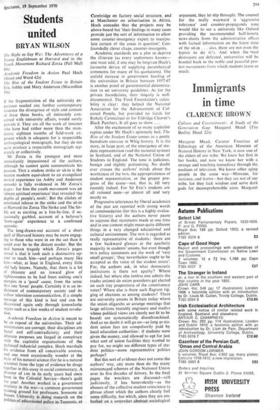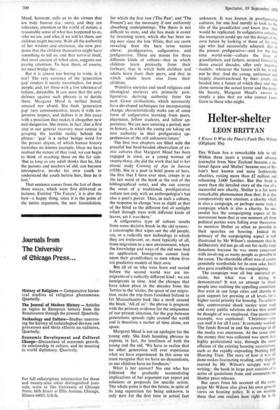Immigrants in time
CLARENCE BROWN
Culture and Commitment: A Study of the Generation Gap Margaret Mead (The Bodley Head 22s)
Margaret Mead, Curator Emeritus of Ethnology of the American Museum of Natural History in New York, is now one of the elders of our tribe. We knew her first in her books, and now we know her with a strange and touching immediacy through the. medium of television. We know other aging people in the same way—Marcuse, for instance, and Sartre—but they are not of our tribe, for they lack wisdom and serve dark gods for incomprehensible aims. Margaret
Mead, however, calls us to the virtues that are truly human (i.e., ours), and they are tolerance, attention to the world of nature, a reasonable sense of what has happened to us, who we are, and who, if we will let them, our children might become. With all the authority of her wisdom and eminence, she now pro- poses that the children themselves might have something to tell us, and that survival itself, that most ancient of tribal aims, suggests our paying attention. To hear them, of course, we must bridge the ...
But it is almost too boring to write, is it not? The very currency of the 'generation gap' renders it nearly meaningless, for most people, and, for those with a low tolerance of tedium, detestable. It can seem that the only defence against such phrases is to deride them. Margaret Mead is neither bored, amused nor afraid. She finds 'generation gap' very communicative, treats it with im- pressive respect, and defines it in this essay with a precision that makes it altogether new and dangerous. She insists, in fact, that a first step in our general recovery must consist in grasping the terrible reality behind the phrase: 'gap' is a rather benign word for the present abysm, of which human history furnishes no known example. Once we have realised the nature of that void, we can begin to think of reaching those on the far side. 'But as long as any adult thinks that he, like the parents and teachers of old, can become introspective, invoke his own youth to understand the youth before him, then he is lost.'
That sentence comes from the last of these three essays, which were first delivered as lectures. Entitled The Future', it is also the best—a happy thing, since it is the point of the entire argument, the new formulation,
for which the first two (The Past', and The Present') are the necessary if not uniformly absorbing underpinnings. The thesis is not difficult to state, and she has made it easier by inventing terms, which she has been us- ing now since the late 'fifties, that are more revealing than the bare tense names above: postfigurative, cofigurative, and prefigurative. These are names for three different kinds of culture—that in which children learn primarily from their forbears, that in which both children and adults learn from their peers, and that in which adults learn also from their children.
'Primitive societies and small religious and ideological enclaves are primarily post- figurative, deriving authority from the past. Great civilisations, which necessarily have developed techniques for incorporating change, characteristically make use of some form of cofigurative learning from peers, playmates, fellow students, and fellow ap- prentices. We are now entering a period, new in history, in which the young are taking on new authority in their prefigurative ap- prehension of the still unknown future.'
The first two chapters are filled with the graceful but hard-headed observation of ex- otic cultures that Margaret Mead has been engaged in since, as a young woman of twenty-three, she did the work that led to her classic study Coming of Age in Samoa (1928). She is a poet (a brief poem of hers, the first that I have ever seen, creeps in as the last word of the book at the end of the bibliographical note), and she can convey the sense of a traditional, postfigurative culture not only with an anthropologist's but also a poet's power. Thus, in such a culture, the response to change 'was as slight as that of the blind to the different feel of sunlight sifted through trees with different kinds of leaves, yet it was there.'
A cofigurative type of culture results from some decisive break in the old system: a catastrophe that wipes out the old people, say, or a radically new technology to which they are irrelevant, or, most typically of all, from migration to a new environment, where the knowledge and ways of the old men find no application. Immigrants cannot look upon their grandfathers as men whose lives are predictive models of their own.
But all of us who were born and reared before the second world war are im- migrants of a radically different kind : we are immigrants in time. And the changes that have taken place in the decades from the 'forties to the 'sixties, the space of our migra- tion, make the trip from famished Ireland to fat Massachusetts look like a stroll around the block. 'All of us': the phrase is pregnant with the primary evidence for the uniqueness of our present situation, for the gap between generations spreads right around' the world and is therefore a matter of time alone, not space.
Margaret Mead is not an apologist for the young only. She finds haunting phrases to express, in fact, the loneliness of both the young and the old. 'We have to realise that no other generation will ever experience what we have experienced. In this sense we must recognise that we have no descendants, as our children have no forebears' What is her answer? No one who has followed the gradually accumulating implications of her argument can expect pat solutions or proposals for specific action. The whole point is that the future, in spite of its long reputation for being unknown, is only now for the first time in actual fact
unknown. It was known in postfigurative cultures, for one had merely to look to the life of the grandfather and know that that would be replicated. In cofigurative cultures, the immigrant could spy out the design of his own future by looking at those of his own age who had successfully adapted. But in the present prefigurative—and for the first time world-wide--culture the lives of grandfathers, and fathers, severed forever by those crucial decades, offer only negative
• models: whatever the future will be, it will not be that. And the young, unformed and largely disenfranchised by their youth, are headed into a future of which they and they alone surmise the actual terror and the possi- ble beauty. Margaret Mead's answer is simply a plea that we who cannot know listen to those who might.



































 Previous page
Previous page